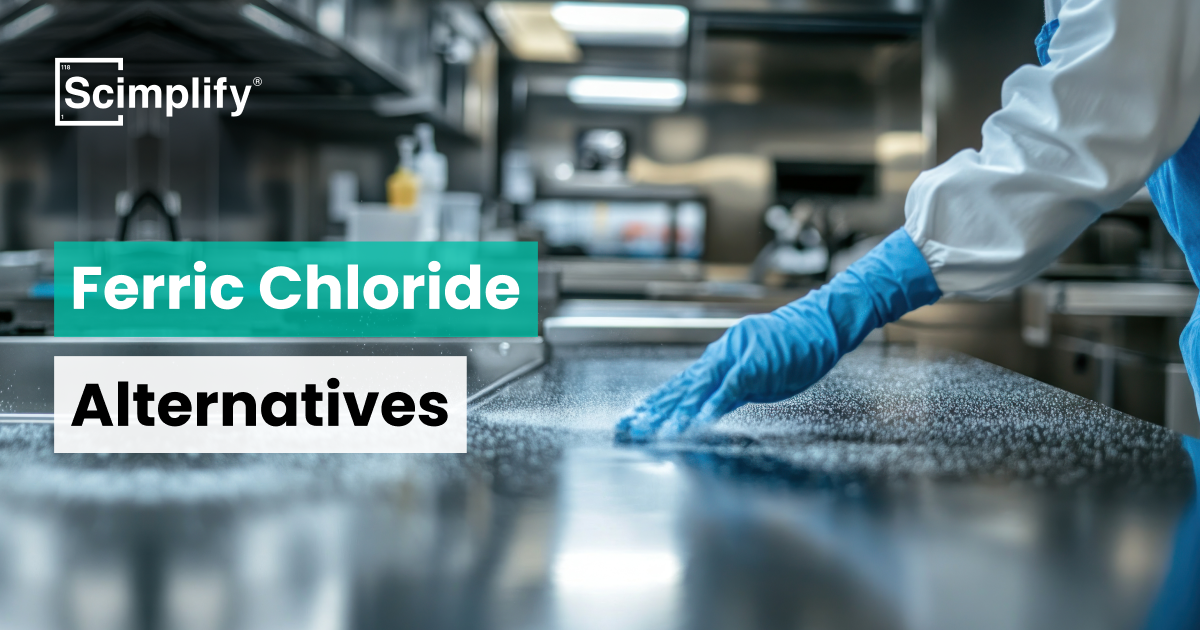Ferric Chloride (FeCl 3 ) is a highly efficient and multi-purpose inorganic chemical that possesses outstanding coagulation and oxidation capabilities. It presents as a dark brown to black crystalline solid or solution, which is slightly soluble in many solvents except that it is soluble to a high extent in water to give acidic solutions. It is a well-known, powerful oxidizing agent as well as a Lewis acid that is important in both industrial and municipal processes.
Ferric Chloride has numerous applications, such as the treatment of water, electronic etching, pigments, and as a catalyst. Nonetheless, its corrosivity and handling hazards are propelling industries to find safer, cost-efficient, and sustainable options that need not affect performance.
Looking to test Ferric Oxide quality? Request a Sample
Alternative Products of Ferric Chloride
Top 10 alternatives to Ferric Chloride with their pros and cons:
1. Aluminum Sulfate (Alum)
Alum is the most popular water and wastewater coagulant and may be used instead of Ferric Chloride in the water treatment process because of its high efficiency.
- Pros
- Cost-effective and widely available.
- Produces less sludge volume than ferric salts.
- Effective in low-turbidity waters.
- Cons
- Generates sulfate residuals.
- Performance decreases in cold water.
- Requires pH adjustment for optimal efficiency.
2. Poly Aluminum Chloride (PAC)
A pre-polymerized coagulant (PAC) has greater efficiency and reduced sludge production than Ferric Chloride applications.
- Pros
- Works effectively over a wide pH range.
- Produces compact, easily settled flocs.
- Reduces chemical consumption compared to ferric salts.
- Cons
- More expensive than ferric chloride.
- Handling requires care to avoid overdosing.
3. Ferrous Sulfate (FeSO₄)
A cheaper alternative for coagulation and odor control in wastewater.
- Pros
- Cost-effective and widely available.
- Effective for phosphorus removal.
- Ferrous Sulfate is Less corrosive than ferric chloride.
- Cons
- An oxidation step is needed for full efficiency.
- Generates more sludge than PAC.
4. Magnesium Hydroxide
It is used as an alkaline coagulant and neutralizing agent for the wastewater.
- Pros
- Presents a pH buffering capacity.
- Safe and easy to work with Environmental friendly.
- Lowers the odor and heavy metals.
- Cons
- Lower rate of reaction compared to ferric chloride.
- Bulkier chemical, requiring higher dosages.
5. Lime (Calcium Hydroxide)
Lime is often used for pH adjustment and as a coagulant in water treatment.
- Pros
- Inexpensive and abundant.
- Controls acidity while coagulating impurities.
- Effective in large-scale municipal plants.
- Cons
- High sludge production.
- Handling requires dust and safety control.
6. Sodium Aluminate
Used as a coagulant and pH-adjusting agent in combination with other chemicals.
- Pros
- High alkalinity; reduces need for extra lime.
- Works synergistically with alum or PAC.
- Effective in phosphorus removal.
- Cons
- More expensive than alum or lime.
- Limited stand-alone performance.
7. Chlorine Dioxide
An effective disinfectant and smell remover in strong oxidizing forms.
- Pros
- Strong antiseptic; effective against biofilms.
- Not toxic chlorinated byproducts such as chlorine gas.
- Decreases sulfides that cause odor.
- Cons
- More expensive compared to ferric chloride.
- Requires on-site generation.
8. Polymers (Cationic & Anionic)
Synthetic polymers are often used as flocculants in conjunction with or instead of metal salts.
- Pros
- Highly efficient at low dosages.
- Produces very little sludge.
- Tailored grades for specific wastewater types.
- Cons
- Higher purchase cost.
- Requires precise dosing control.
9. Titanium-Based Coagulants
Emerging alternative in advanced wastewater treatment.
- Pros
- High removal efficiency for turbidity and organics.
- Produces recyclable sludge (titanium oxides).
- Effective across wide pH ranges.
- Cons
- Expensive and less available in bulk.
- Limited industrial adoption.
10. Natural Coagulants (Moringa Seeds)
Eco-friendly bio-based coagulants, increasingly researched for replacing Ferric Chloride for water treatment.
- Pros
- Renewable, biodegradable, and safe.
- Lower environmental footprint.
- Useful in rural or low-cost applications.
- Cons
- Limited large-scale effectiveness.
- Variability in raw material quality.
- Requires further R&D for industrial scaling.



